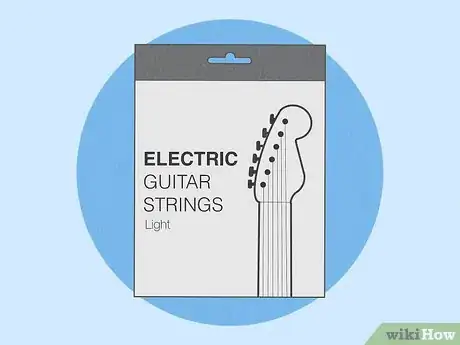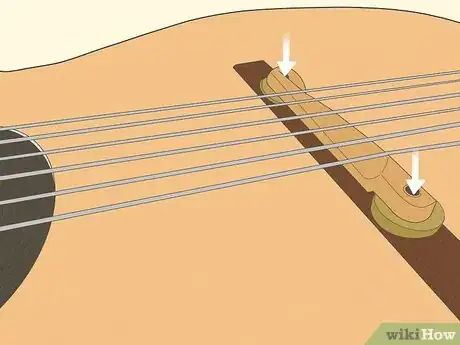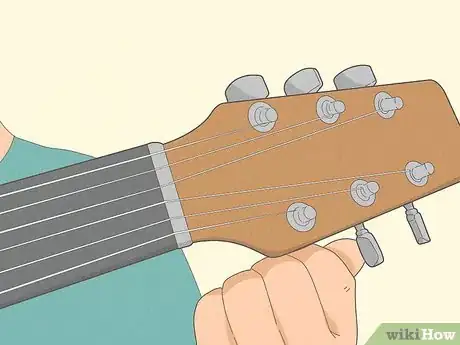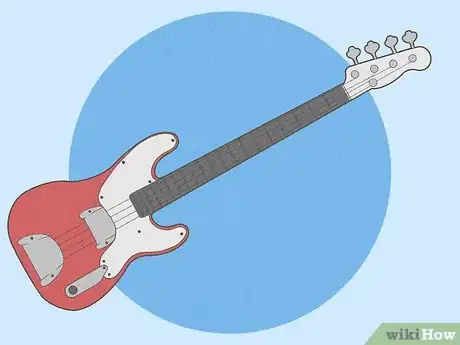This article was co-authored by wikiHow staff writer, Jennifer Mueller, JD. Jennifer Mueller is a wikiHow Content Creator. She specializes in reviewing, fact-checking, and evaluating wikiHow's content to ensure thoroughness and accuracy. Jennifer holds a JD from Indiana University Maurer School of Law in 2006.
There are 13 references cited in this article, which can be found at the bottom of the page.
This article has been viewed 23,670 times.
Learn more...
Guitar strings need a particular tension to play in tune. While technically you are adjusting the tension in your strings when you tune your guitar, you can't do anything to change that final tension you reach. If the strings are difficult to play when the guitar is in tune, you can reduce the tension by choosing a lighter gauge of strings or switching to a shorter scale guitar.[1] On the other hand, if you feel like the strings don't have enough tension and they feel too loose and sloppy, switch to a higher gauge string or go with a longer scale guitar. If you're still having problems with tension, adjusting the action on your guitar (the distance between the strings and the frets) will make it easier to play. Unless you're experienced in guitar repair, have a guitar tech or luthier make these adjustments for you.[2]
Steps
Changing Your Strings
-
1Use heavier gauge strings if you want more string tension. Online or at a guitar shop, look for strings with the heaviest gauge — they'll have the highest number range, and typically include the word "heavy" on the package. When you put these strings on your guitar, they'll feel stiffer and be much more difficult to fret or bend.[3]
- Generally, the higher the gauge, the more tension your strings will have when they're tuned to pitch.
- If you're a heavy strummer or play rhythm guitar in a heavier genre, such as punk or metal, you'll likely do better with a heavier string gauge.[4]
-
2Switch to a lighter gauge if you want less string tension. Most beginner guitars already come equipped with relatively light strings. However, if you still find those difficult to play and want less tension, a lighter gauge might do the trick.[5]
- A pack of 8s is typically the lightest guitar string you can find. Some brands make strings with different materials so that they feel even lighter, even if they're the same gauge. You might want to experiment with that as well.
- Lighter gauge strings do tend to lose tension more quickly, so you might find that you need to retune your guitar more often while you're playing.
Advertisement -
3Try electric guitar strings on an acoustic guitar to go even lighter. Electric guitar strings, generally, are lighter than acoustic guitar strings. If playing your acoustic guitar is giving your fretting hand a workout, you might find that electric guitar strings feel better.[6]
- If you put electric guitar strings on an acoustic guitar, you'll likely notice a decrease in sound quality. However, if you're still just learning, you can switch back to heavier strings once your fretting hand starts getting stronger and you develop more confidence in your playing.
-
4Move up or down one gauge at a time to start. Guitar strings come in gauges ranging from extremely light (0.008 - 0.038) to heavy (0.012 - 0.054). Moving up or down even one gauge can feel tremendously different and take some time to get used to, especially if you've been playing for a while with the original gauge.[7]
- Because different brands use different names for gauges, guitarists commonly refer to them by the smallest number in the range. For example, if you say that you want a "pack of 10s," you're asking for a pack of strings with gauges that range from 0.010 to 0.046.
- For example, if your guitar came with 10s and you think those strings are too heavy, you might drop down to 9s. Play on 9s for a few weeks and if they still feel too heavy, drop down to 8s.
-
5Get your guitar set up again if you change by more than one gauge. While you can complete a guitar setup yourself, you'll typically be better off taking it to an experienced guitar tech or luthier. You might save some money doing it yourself, but you also risk causing serious damage to your guitar if you've never done any guitar repair before.[8]
- A basic guitar setup involves adjusting the truss rod and saddle height so your strings have proper relief, action, and intonation, all related to the distance between the strings and the frets. Since different string gauges have different thicknesses, this changes that distance.
- When your guitar was initially set up, it was likely set up to work with the gauge of strings that originally came on it. If you only go up or down by one gauge, say from 10s to 11s (or vice versa), your guitar setup should be fine. But if you go up from 10s to 12s, you likely need a new setup.
Making Your Guitar Easier to Play
-
1Adjust the truss rod to correct neck relief. Use a hex key to turn the truss rod (typically accessible from the headstock of your guitar) to change the curve of your neck. Neck relief is highly subjective and depends on your playing style. However, if you play with a light to moderate touch, you'll typically be more comfortable with less relief.[9]
- Many guitarists will adjust their truss rod themselves. However, if you're a beginner, get a guitar tech or a more experienced guitarist to help you. If you tighten the truss rod too much, you can snap the neck of your guitar.
-
2Lower the height of your saddle to make strings easier to fret and bend. Measure the distance between the string and the fret at the 12th fret. If you want the strings to be closer to the fret, turn the bridge screws to the left to lower it. If you want the strings further away from the fret, raise the height of the saddle by turning the bridge screw to the right.[10]
- Lowering the height of your strings also makes it easier to fret notes because you don't have to push them down as far. Higher strings require more effort from your fretting hand.
- If you have a Fender guitar, you can adjust the bridge height of each string individually.
-
3Change the height of the strings at the nut. Use a file to increase the depth of the notches in the nut where your strings sit. If you're doing this yourself, be careful — you can't replace any part of the nut that you've filed away if you're unhappy with it. Typically, you're better off getting an experienced guitar tech or luthier to make this adjustment for you.[11]
- You can also look for a different nut with a lower profile and simply swap your guitar's nut out with that. Generally, this will help your strings sit closer to the frets, so they're easier to play.
- If you want to increase the height of your strings at the nut (which would increase string tension), you can add a shim underneath the existing nut or buy a new nut with a higher profile.
-
4File down the frets to reduce action even further. If you're still having difficulty playing your guitar, take it to a luthier to have the frets filed down. Don't attempt this repair on your own, even if you have some experience working on your guitar. Filing frets requires a specific set of tools and precise measurements. If you get them uneven, you'll ruin your guitar.[12]
- If the luthier files down your frets, this lets you lower the action even more, which will ultimately make your guitar easier to play.
- Only do this as a last resort. If you end up wanting to change the height of your frets again later on, your only recourse may be to have them replaced entirely, which can be an expensive repair.
Choosing a Properly Sized Guitar
-
1Find a neck size and shape that fits your hand and playing style. Slim V-neck guitars are usually designed so that you can loop your thumb around to the fretboard, which makes them very easy to play, especially if you have smaller hands. For larger hands, look for a guitar with a wider neck and a deeper curve.[13]
- Wider necks are also typically more comfortable for fast playing or finger-picking because they give you more room to maneuver.
- If you've just started learning the guitar or are shopping for your first guitar, you won't have much to go on in terms of your playing style — but you likely still have an idea of the type of music you'd like to play. Focus on a neck that feels good in your hands and will enable you to one day play the type of music you're most interested in.
-
2Try a reduced-size guitar if the body is too big for you to handle. Smaller guitars tend to be easier to play because they're not as heavy and fit in your hands and arms more easily. However, they also have a shorter scale, which means they have lower string tension than full-size guitars.[14]
- If you're a smaller-statured person or have smaller hands, a reduced-size guitar might be a more comfortable fit.
- Keep in mind that you can also find full-size guitars with shorter scales. If string tension is your biggest concern, focus on scale length rather than the overall size of the guitar.
-
3Play different scale lengths to compare comfort and playability. The scale of a guitar is the length of the vibrating part of the string, generally measured from the nut to the bridge. As the scale gets longer the string tension increases.[15]
- Guitars with a longer scale also have a greater distance between the frets. If you have larger hands, you might find that a longer scale guitar is more comfortable.
- The scale length of a guitar has little to do with the type of music you play. You can play any style on any scale — the question is how comfortable the instrument is for you to play.
-
4Go with a shorter scale guitar if you want the lowest string tension. With a short-scale guitar, you get lower tension even on strings with heavier gauges. If you don't enjoy playing on the lightest gauge strings, you might find a short-scale guitar more accommodating.[16]
- Short-scale guitars also tend to be quieter instruments that don't require a lot of effort to play. This makes them good if you're a beginner who's still working on your hand strength and flexibility.
- While you can play any kind of music on a shorter scale guitar, the lower tension makes this guitar particularly well-suited to a looser style of playing that includes lots of bends and vibrato.
-
5Use a longer scale guitar for higher string tension. With a longer scale guitar, your strings will be tight and stiff. These guitars are typically best if you have a little experience playing guitar and prefer to play in a hard, driving style, such as hard rock or heavy metal.[17]
- You might also prefer a longer scale if you have a heavy hand. The higher string tension means your strings won't fall out of tune as often.
Warnings
- If you want to adjust the action of your guitar to make it easier to play, take it to an experienced guitar tech or luthier. If you attempt to do this yourself and have no experience with guitar repair, you could irreparably damage your instrument.⧼thumbs_response⧽
- Find the gauge of strings you like best before you do anything about the action. Otherwise, you might have to adjust the action all over again. If you're getting a guitar tech to make these adjustments for you, multiple adjustments can be costly.[20]⧼thumbs_response⧽
References
- ↑ https://sixstringacoustic.com/how-can-i-reduce-acoustic-guitar-string-tension
- ↑ https://youtu.be/p7OOYR4rXcg?t=45
- ↑ https://www.stringsdirect.co.uk/blog/string-tension-101/
- ↑ https://guitargearfinder.com/guides/ultimate-guide-to-guitar-strings/
- ↑ https://guitargearfinder.com/guides/ultimate-guide-to-guitar-strings/
- ↑ https://youtu.be/p7OOYR4rXcg?t=83
- ↑ https://guitargearfinder.com/guides/ultimate-guide-to-guitar-strings/
- ↑ https://sixstringacoustic.com/how-can-i-reduce-acoustic-guitar-string-tension
- ↑ https://hazeguitars.com/blog/a-truss-rod-is-not-for-adjusting-action
- ↑ https://www.sweetwater.com/sweetcare/articles/guitar-setup-part-2-setting-action/
- ↑ https://youtu.be/p7OOYR4rXcg?t=153
- ↑ https://theartoflutherie.com/fret-crowning-files/
- ↑ https://themusicambition.com/acoustic-guitar-neck-guide/
- ↑ https://guitargearfinder.com/guides/guitar-for-small-hands/
- ↑ https://guitargearfinder.com/guides/ultimate-guide-to-guitar-scale-length/
- ↑ https://guitargearfinder.com/guides/ultimate-guide-to-guitar-scale-length/
- ↑ https://guitargearfinder.com/guides/ultimate-guide-to-guitar-scale-length/
- ↑ https://guitargearfinder.com/guides/guitar-for-small-hands/
- ↑ https://youtu.be/_g_B1DrET1k?t=50
- ↑ https://sixstringacoustic.com/how-can-i-reduce-acoustic-guitar-string-tension









































































